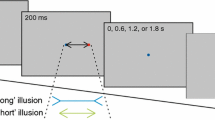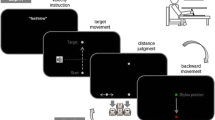Abstract
Participants made perceptual judgments about the length of, and manual aiming movements to the opposite end of, formerly visible Müller-Lyer stimuli. The Müller-Lyer illusion affected both perceptual judgments and aiming amplitude. Manipulations of stimulus duration (10 ms or 3,000 ms) and memory delay length (10 ms or 3,000 ms) had no impact on the illusory effect. Aiming movements executed with vision of the hand were less affected by the illusion than movements executed without vision of the hand. The effect of the illusion on aiming amplitude remained the same between peak velocity and the end of the movement even though participants were engaged in on-line control between peak deceleration and the end of the movement. This latter finding was counter to the predictions of a hypothesis (Glover 2002) stating that illusions should only affect the early (planning) stages of movement and not the late (control) stages of movement. We conclude that a single visual representation is used for perception, motor planning, and motor control.






Similar content being viewed by others
Notes
The purpose of the pattern mask was to prevent continued visual processing of the stimulus following the exposure period.
Khan et al. (2003) have demonstrated that decreases in spatial variability do not occur between peak deceleration and the end of the movement if participants have insufficient time or opportunity to use on-line feedback. Thus the changes in variability over the course of the trajectory do not appear to be an artifact of data acquisition or reduction procedures.
Although the analysis of the relative amplitudes revealed no change in the illusion-induced bias from early to late kinematic landmarks, a similar analysis of absolute amplitudes (i.e., not scaled by tail-less amplitudes) revealed an increase in the impact of the illusion at the end of the movement relative to early kinematic landmarks.
Although the aiming movements in the current study were executed rapidly, there was still ample time for feedback utilization (Elliott and Allard 1985; Zelaznik et al. 1983), as is evidenced by the variable and constant error advantages associated with visual feedback availability in Experiment 2.
Other results that are problematic for the planning-control hypothesis were reported by Proteau and Masson (1997) and Brenner and Smeets (1997), who found that a perturbation of the visual background underlying a target had a significant effect on target-directed accuracy, even though the perturbation was not introduced until after a movement was initiated. In other words, visual perceptual information was available to control processes.
References
Binsted G, Elliott D (1999a) Ocular perturbations and retinal/extraretinal information: the coordination of saccadic and manual movements. Exp Brain Res 127:193–206
Binsted G, Elliott D (1999b) The Müller-Lyer illusion as a perturbation to the saccadic system. Hum Mov Sci 18:103–117
Binsted G, Chua R, Helsen W, Elliott D (2001) Eye-hand coordination in goal-directed aiming. Hum Mov Sci 20:563–585
Brenner E, Smeets JBJ (1996) Size illusion influences how we lift but not how we grasp an object. Exp Brain Res 111:473–476
Brenner E, Smeets JBJ (1997) Fast responses of the human hand to changes in target position. J Mot Behav 29:297–310
Bridgeman B, Peery S, Anand S (1997) Interaction of cognitive and sensorimotor maps of visual space. Percept Psychophys 59:456–469
Bridgeman B, Gemmer A, Forsman T, Huemer V (2000) Processing spatial information in the sensorimotor branch of the visual system. Vision Res 40:3539–3552
Bruno N (2001) When does action resist visual illusions? Trends Cogn Sci 5:379–382
Carey DP (2001) Do action systems resist visual illusions? Trends Cogn Sci 5:109–113
Carlton LG (1981) Visual information: the control of aiming movements. Q J Exp Psychol 33A:87–93
Chua R, Elliott D (1993) Visual regulation of manual aiming. Hum Mov Sci 12:365–401
Daprati E, Gentilucci M (1997) Grasping an illusion. Neuropsychologia 35:1577–1582
Elliott D, Allard F (1985) The utilization of visual feedback information during rapid pointing movements. Q J Exp Psychol A 37:407–425
Elliott D, Lee TD (1995) The role of target information on manual-aiming bias. Psychol Res 58:2–9
Elliott D, Madalena J (1987) The influence of premovement visual information on manual aiming. Q J Exp Psychol A 39:541–559
Elliott D, Calvert R, Jaeger M, Jones R (1990) A visual representation and the control of manual aiming movements. J Mot Behav 22:327–346
Elliott D, Carson RG, Goodman D, Chua R (1991) Discrete vs. continuous control of manual aiming. Hum Mov Sci 10:393–418
Elliott D, Binsted G, Heath M (1999) The control of goal-directed limb movements: correcting errors in the trajectory. Hum Mov Sci 18:121–136
Elliott D, Helsen WF, Chua R (2001) A century later: Woodworth’s (1899) two-component model of goal-directed aiming. Psychol Bull 127:342–357
Fodor J (1983) The modularity of mind. MIT Press, Cambridge, MA
Franz VH (2001) Action does not resist visual illusions. Trends Cogn Sci 5:457–459
Franz VH, Fahle M, Bulthoff HH, Gegenfurtner KR (2001) Effects of visual illusions on grasping. J Exp Psychol Hum Percept Perform 27:1124–1144
Gentilucci M, Chieffi S, Deprati E, Saetti MC, Toni I (1996) Visual illusion and action. Neuropsychologia 34:369–376
Glover S (2002) Visual illusions affect planning but not control. Trends Cogn Sci 6:288–292
Glover S, Dixon P (2001a) Dynamic illusion effects in a reaching task: evidence for separate visual representations in the planning and control of reaching. J Exp Psychol Hum Percept Perform 27:560–572
Glover S, Dixon P (2001b) Motor adaptation to an optical illusion. Exp Brain Res 137:254–258
Glover S, Dixon P (2001c) The role of vision in the on-line correction of illusion effects on action. Can J Exp Psychol 55:96–103
Glover S, Dixon P (2002) Dynamic effects of the Ebbinghaus illusion in grasping: support for a planning/control model of action. Percept Psychophys 64:266–278
Goodale MA (1988) Modularity in visuomotor control: from input to output. In: Pylyshyn Z (ed) Computational processes in human vision: an interdisciplinary perspective. Ablex, Norwood, NJ, pp 262–285
Jackson SR, Shaw A (2000) The Ponzo illusion affects grip-force but not grip-aperture scaling during prehension movements. J Exp Psychol Hum Percept Perform 26:418–423
Khan MA, Elliott D, Coull J, Chua R, Lyons J (2002) Optimal control strategies under different feedback schedules: kinematic evidence. J Mot Behav 34:45–57
Khan MA, Lawrence G, Fourkas A, Franks IM, Elliott D, Pembroke S (2003) Online versus offline processing of visual feedback in the control of movement amplitude. Acta Psychol 113:83–97
Milgram P (1987) A spectacle-mounted liquid-crystal tachistoscope. Behav Res Methods Instrum Comput 19:449–456
Milner AD, Goodale MA (1995) The visual brain in action. Oxford University Press, Oxford
Otto-de Haart EG, Carey DP, Milne AB (1999) More thoughts on perceiving and grasping the Müller-Lyer illusion. Neuropsychologia 37:1437–1444
Pepper RL, Herman LM (1970) Decay and interference effects in the short-term retention of a discrete motor act. J Exp Psychol 83:1–18
Post RB, Welch RB (1996) Is there dissociation of perceptual and motor responses to figural illusions? Perception 25:569–581
Proteau L, Masson G (1997) Visual perception modifies goal-directed movement control: supporting evidence from a visual perturbation paradigm. Q J Exp Psychol A 50:726–741
Smeets JBJ, Brenner E (2001) Action beyond our grasp. Trends Cogn Sci 5:287–287
Smeets JBJ, Brenner E, de Grave DDJ, Cuijpers RH (2002) Illusions in action: consequences of inconsistent processing of spatial attributes. Exp Brain Res 147:135–144
Westwood DA, Heath M, Roy EA (2000) The effect of a pictorial illusion on closed-loop and open-loop prehension. Exp Brain Res 134:456–463
Westwood DA, McEachern T, Roy EA (2001) Delayed grasping of a Müller-Lyer figure. Exp Brain Res 141:166–173
Wong E, Mack A (1981) Saccadic programming and perceived location. Acta Psychol 48:123–131
Woodworth RS (1899) The accuracy of voluntary movement. Psychol Rev 3 (Suppl 13):1–119
Zelaznik HN, Hawkins B, Kisselburgh L (1983) Rapid visual feedback processing in single-aiming movements. J Mot Behav 15:217–236
Acknowledgements
This research was supported by the Natural Sciences and Engineering Research Council of Canada and the Canada Research Chair program. We thank John Moroz for technical support.
Author information
Authors and Affiliations
Corresponding author
Rights and permissions
About this article
Cite this article
Meegan, D.V., Glazebrook, C.M., Dhillon, V.P. et al. The Müller-Lyer illusion affects the planning and control of manual aiming movements. Exp Brain Res 155, 37–47 (2004). https://doi.org/10.1007/s00221-003-1702-3
Received:
Accepted:
Published:
Issue Date:
DOI: https://doi.org/10.1007/s00221-003-1702-3




